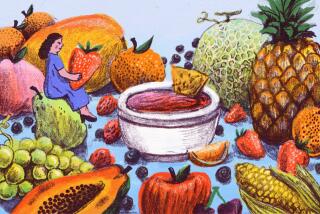Topsy-Turvy Harvest : Chile Exports Summer With Off-Season Fruit
- Share via
To shoppers it may have seemed like June in January this winter as fresh nectarines, peaches, plums and grapes made unseasonal appearances in the produce sections of the nation’s supermarkets.
But since the last of California’s 1984 harvest left cold storage before Christmas, these winter displays represented the fruits of growers’ summer labors in Chile. Because it has now become roughly August in March, Chile’s Granny Smith apple crop has ripened. The latest shipment of apples--and still more grapes--arrived last week at the Port of Los Angeles on the Japanese-registered freighter Levante.
According to Rick Eastes of Grenada International Importers, which is based in Visalia, Calif., the seasonally topsy-turvy fruit displays are becoming commonplace. Improved handling and shipping techniques have lowered freight costs enough to transform a luxury item into a common purchase, and once-seasonal fruits into staples.
“People are going into the supermarkets and seeing this fruit and they’re not used to it,” Eastes said.
This transformation is evident in the dramatic growth of Chilean grape imports. These totaled 29 million pounds 10 years ago, virtually all of it delivered to East Coast ports. This year they’re expected to top 500 million pounds--about 25% of it delivered to the West Coast, mostly Los Angeles, according to data compiled by the Chilean Winter Fruit Assn. in San Francisco.
Estimates of the retail value of this year’s Chilean fruit range up to $700 million, accounting for the mounds of fresh summer fruits now heaped in produce bins. By comparison, bananas, the best-selling fruit in the United States, recorded sales of $805 million last year.
The Chilean Winter Fruit Assn., which is supported by importers, growers and the Chilean government, is helping promote sales this year with point-of-sale display materials, heavy advertising in the trade press and a heavy radio advertising campaign, now in full swing in the 25 top U.S. markets and in Vancouver, Toronto and Montreal, Canada.
Eastes and other importers, who also handle California produce, say the Chilean fruit complements rather than competes with domestic crops.
“Overlay Chile on the West Coast,” Eastes explained, “and it stretches from Juneau to Baja, with the same range of climate.” The Chilean port of Valparaiso, for example, lies about as far south of the Equator as Los Angeles lies north of it. Chile’s harvest runs from January into May, beginning within a week or two of when domestic fresh-fruit inventories are exhausted and ending just as California’s crops begin coming to market.
Pandol Bros., based in Delano, Calif., has been importing fruit from Chile for 11 years, according to David Sudduth, import coordinator. “It’s a growing business, and a lot of new people are in the (import) business,” he said. “The base is really expanding.” Chile expects production to continue to increase by about 15% a year, he said.
Improved handling in Chile and modern, refrigerated freighters like the Levante, which can make the 5,500-mile voyage from Valparaiso to Los Angeles in 12 days, are significant factors in the rapid growth of Chilean fruit’s presence in the United States, Eastes said.
Until very recently, fresh produce had to be shipped by air at a cost of about $1.50 a kilo (2.2 pounds), Sudduth said. By sea, the cost drops to about $1.50 per 5-kilo crate. The result: lower retail prices. “Cherries at $2.99 a pound don’t move like cherries at $1.49,” he said.
That development also coincides with a marked increase in U.S. demand for fresh fruits and vegetables. U.S. Department of Agriculture statistics show, for example, that Americans now consumes 26 more pounds of fresh produce a year per capita than they did 10 years ago. Supermarket surveys have found, too, that customers are most attracted to the quality and selection in a market’s produce department, said a spokesman for Oakland-based Safeway, the nation’s largest chain of supermarkets. In response they have increased the floor space of their produce departments by 25% in the last four years.
“Traditionally, a supermarket’s worst quarter is the first, because there’s nothing going through the cash register,” Eastes said. “They just don’t have a lot (of fresh produce) to sell in winter--and these stores are beginning to see these items as a staple.”
More to Read
Eat your way across L.A.
Get our weekly Tasting Notes newsletter for reviews, news and more.
You may occasionally receive promotional content from the Los Angeles Times.








